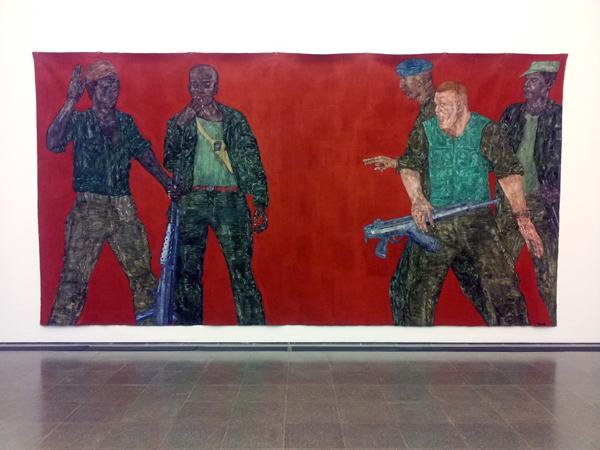Serpentine Galleries presents Leon Golub: ‘Bite Your Tongue’, a survey exhibition of the American figurative painter, his first in London since 2000, highlights key aspects of the artist’s oeuvre from the 1950s until his death in 2004. This exhibition at the Serpentine Gallery is part of the Serpentine’s Spring Programme, which includes an exhibition by Cameroon-born artist Pascale Marthine Tayou presented concurrently at the Serpentine Sackler Gallery.
Golub was born in Chicago in 1922, and began painting in the figurative style in the early 1950s. Labelled as a ‘Chicago Imagist’, he was a member of the post-war artists’ group known as Monster Roster. The artist served in World War II, along with a number of the group, and subsequently obtained fine arts degrees as a result of the American GI Bill. The group held fast to the principles of figurative art during a period when Abstraction held court on the international art scene.
On entering the Serpentine gallery, the viewer is met with Golub’s large-scale works, some of which are floor-to-ceiling pieces, the viewer finds themselves witness to torture sessions, the violence of El Salvador, and other conflict zones where horror is perpetrated with a sense of normality. Golub’s paintings draw the viewer uncomfortably close – dragging you inside the works – as both victim and perpetrator of daily horror, this is all normal – it’s how we behave after all? In fact Golub himself said of the work, “I make certain claims about the paintings that people aren’t willing to accept; one of them is that you’re all in the paintings too”.
The artist’s earlier works forged his relationship with paint, Golub’s surfaces are heavily worked, and the paint is truly weighty. The artist began by using archetypes such as the Sphinx to explore the struggle between nature and humanity, between the nature of violence and its prevalence in ‘civilisation’. With ‘Colossal Torso II’, 1959, a huge work of lacquer on canvas, the work looks as if the artist has carved it out of paint. Golub’s response to the truth and violence of civilisation went beyond the mere image, even if forms take on slightly more traditional figuration in later works; the use of paint is always a factor. Whether the artist layers and ‘carves’ his forms from heavy acrylics, or expresses the savagery of man with a hard brush-stroke, Golub begins and ends at the visceral table of 20th century painting. A table shared by the likes of British painter Francis Bacon, who had a similar preoccupation with violence – if less politicised – and coincidently, an equal fascination with animals as a signifier of violence, including the use of the sphinx in his own work.
Like Bacon, Golub, brought a classical interest to the viscera of his work; ‘Colossal Torso II’ is almost sculpture in itself, via the artist’s use of paint as a material to almost sculpt. Golub creates scenes of horror and degradation – sometimes even ‘redacting’ sections of the canvas by cutting out a section, leaving the viewer to wonder what act the artist had decided to censor, or possibly placing the obscene in our minds when in fact the redacted area was blank? But Golub’s own capacity for violence is present in his brushwork – the artist was in his paintings too, from the beginning to the very end; honing his ability in painting the torpidly overwrought viscera of bodies behaving badly.
In the 60s Golub moved to New York as the Vietnam war escalated, promoting the artist’s involvement in the anti-war Artists and Writers Protest Group. The East Gallery of the Serpentine exhibits a shift in the artist’s painting; the works become larger, and the aforementioned redactions begin. Golub began to work from images directly from the media, responding directly to the horrors of war, mythological sources, and sports imagery – combined to present battling figures, raw, ‘skinned’ bodies, larger than life. The artist began to scrape the paint away, leaving stains and areas of raw canvas – a theatrical device designed to frame his malevolent characters. But Golub’s figures are simultaneously perpetrators and victims, trapped in a monumental Greek tragedy, exemplified by the artist’s huge work ‘Gigantomachy II’, 1966, which looms over the viewer as part of Golub’s timeless tableau of tragedy.
The North Gallery presents the artist’s famous ‘Mercenaries’ and ‘Interrogation’ series, from the 80s, highly politicised critiques of Americas involvement in counter-insurgency operations in Latin America. These works draw the viewer up close, we become complicit in the activities of his creations, torture, interrogation, and the ensuing threat of violence frozen in a moment of time, as we watch.
The West Gallery shows work from 1988 to 1997, where the artist move into his late style, moving away from direct political reference, with a narrative structure becoming ever-more theatrical in its isolation of characters on a raw canvas background, again a rather Baconian tool. Golub present dystopian environments, punctuated with the symbolism of dogs, skulls, and eagles. The artist’s figures hang in wastelands of emptiness, never-more cynical than in Golub’s sensational painting ‘Agent Orange’ 1993. Sinewy leering protagonists, not the American dream, more the American nightmare.
This mini retrospective of the late artist’s work is long-overdue, and although the Serpentine’s show is impressive enough in its respect for Golub’s talent and raw power – this exhibition serves to highlight that this great painter deserves another much larger scale survey of his powerful and now sadly finite oeuvre. But is America brave enough to hold this mirror up to its own history? – time will no doubt tell.
Leon Golub: Bite Your Tongue – Serpentine Gallery – until 17 May 2015
Words: Paul Black photo and Vine video : P A Black © Artlyst 2015 all rights reserved

